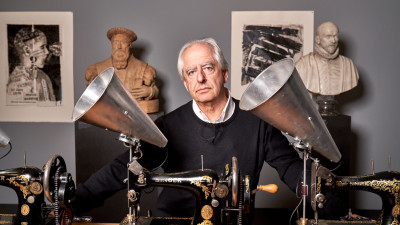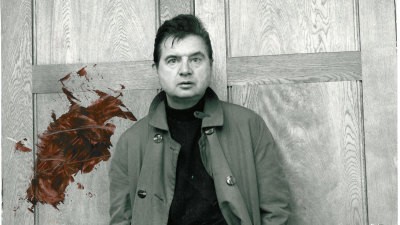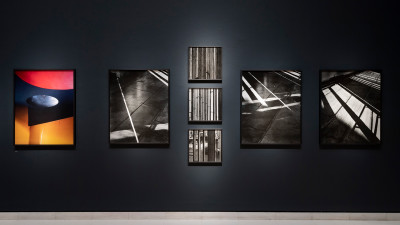Léon Spilliaert: an artist that embraced the dark
Léon Spilliaert: an artist that embraced the dark
By Matthew Beaumont
Published 20 March 2020
Insomniac artist Léon Spilliaert wandered Ostend at night, finding in its empty streets and endless beach the exterior equivalent of his inner isolation. Matthew Beaumont explores the solitude at the heart of his paintings.
-
From the Spring 2020 issue of RA Magazine, issued quarterly to Friends of the RA. Matthew Beaumont is Professor of English Literature and co-director of the Urban Laboratory at University College London. His books include Nightwalking: A Nocturnal History of London, Chaucer to Dickens (Verso).
-
In a remarkable poem from the early 15th century, the Middle-English poet Thomas Hoccleve describes what he calls his “wylde infirmite”. His madness. Series, as Hoccleve’s confessional poem is titled, is sometimes thought to be the first account in the English language of what, in the 21st century, we would call a severe mental health crisis. This psychological collapse, explains Hoccleve in a terse description of his acute sense of social displacement, “me oute of mysilfe caste and threwe.”
The poem’s first section, “Complaint”, contains one especially powerful passage in which Hoccleve reconstructs his experience, when walking through the London streets, of feeling as if, because of his episode of insanity, the people he encounters are ignoring him. The other pedestrians, the poet assumes in his paranoid state, look straight through him when they pass. He returns home deeply disturbed:
And in my chaumbre at home whanne that I was Mysilfe aloone I in this wise wrought: I streite vnto my mirrour and my glas, To loke how that me of my chere thought, If any othir were it than it ought…
Once alone in his room, Hoccleve heads straight to the mirror and studies himself to ascertain whether it is his face that stares back at him or that of someone else. Someone he doesn’t know or understand. The ghost of himself. Perhaps many of us, at one point or another, have experienced something like this moment of alienation when, feeling lost or lonely, we’ve walked like a spectre through the streets of a city. A sudden sense that, because other people don’t know or see us, we don’t know or can’t see ourselves. How do other people perceive me? And do their perceptions correspond in any way to the person I feel I am on the inside? It is a common form of dysmorphia, psychological more than physical. A conviction that my face, and my very sense of self, is “othir,” in Hoccleve’s haunting phrase, “than it ought”.
-

Léon Spilliaert, Self-portrait in Front of a Mirror, 1908.
Indian ink wash, brush, watercolour and coloured pencil on paper. 48.5 x 63.1 cm. Mu.ZEE, Ostend © www.lukasweb.be - Art in Glanders VZW/Photo Hugo Maertens.
-
In the history of painting, Edvard Munch’s various versions of The Scream (1893), with their sickening distortions, might be interpreted as an especially shocking record of this kind of crisis of identity. But the works of the Belgian artist Léon Spilliaert, who was manifestly influenced by Munch, describe an even more obsessive attempt to capture a similar psychodrama on paper. And I am forcefully reminded of Hoccleve’s seminal account of urban alienation whenever I see Spilliaert’s strange, spooky pictures – especially those dating from the time he spent in the small coastal city of Ostend, where he lived with his family, during the opening decade of the 20th century.
The streets and promenades of Ostend feel as if they are spread out against the sea and sky, to paraphrase T.S. Eliot, like a patient etherised upon a table. Spilliaert sought to escape their soporific, stifling influence by tramping them at night, in the bleakest of conditions. And by traversing the endless, elemental beach on foot. “I worked shut up at home all day,” he remarked of his twenties, a formative period in his development as a self-taught artist. “When it grew dark, I went out regardless of the weather, taking long walks for hours along the sea or cross country.” Painful stomach ulcers prevented him from sleeping and made Spilliaert a chronic insomniac. Like Munch, in fact.
Spilliaert’s landscapes, seascapes and self-portraits from the 1900s – testaments of these lonely, relentless nightwalks – are experiments in the hallucinatory effects of physical exhaustion and psychological isolation. His laboratory is the silent, empty beach at night. Look, for example, at Beach Hut (1902). If photographs of Ostend at the turn of the last century celebrate the bustling sociability of the beach, then this drawing on paper is by contrast sinister in its blankness. Its single, isolated hut, a mysterious moonlit box, floats at the bottom left of the composition as if it has been abandoned by a receding tide.
-

Léon Spilliaert, Moonlight and Lights, c.1909.
Pastel and ink wash on paper. 64 x 48.5 cm. Musée d'Orsay, Paris. Gift of Madeleine Spilliaert, 1981/Photo © RMN-Grand Palais (Musée d'Orsay)/Hervé Lewandowski..
-
Spilliaert’s activities as a nightwalker situate him in a tradition that stretches back to the Middle Ages. At that time, curfews were in place in most European towns and cities, and anyone caught outside after dark was liable to be arrested on the grounds that they were criminals; or, at the very least, vagrants up to no good. Subsequently, over the course of several centuries, the curfew was less and less rigidly enforced because of the rise of what today we call the ‘night-time economy’. But, in this new dispensation, throughout the 18th and 19th centuries, a number of important painters, poets and other bohemians walked the streets at night alone, when respectable people were fast asleep in bed, in order deliberately to identify themselves with those historically excluded from bourgeois society. The mad, the bad, the dangerous to know.
In the later 19th century, for example, semi-vagrant poets such as Baudelaire, Nerval and Rimbaud all used the night, along with either alcohol or other intoxicants, to explore a sense of being other than they ought to be. Impressionist and Post-Impressionist painters such as Whistler and Van Gogh also painted nocturnal scenes. Friedrich Nietzsche, a committed wanderer whom Spilliaert ardently admired, and whose portrait he reproduced on several occasions at the turn of the 20th century, was himself probably one of this secret fraternity of nightwalkers. In ‘The Night Song’ section of Thus Spoke Zarathustra, written in the early 1880s, Nietzsche uttered gnomic affirmations of his commitment to the night: “Light am I; ah, that I were night! But this is my loneliness that I am girt with light. Ah, that I were dark and nocturnal!”
-
Spilliaert’s pictures, with their eerie lunar quality, testify both to his loneliness and his longing for the night.
-
Spilliaert’s pictures from the early 1900s, many of which have an eerie lunar quality, testify both to his loneliness and his longing for the night. On the desolate beach after dark, and in the emptied streets of Ostend, scoured as they were by winds barrelling in from the North Sea, the artist both lost and found himself. Back home at the dead of night, staring at himself in the mirror, his reddened eyes stinging from the sand, he cultivated his sense of otherness with both horror and fascination – as his self-portraits reveal.
These almost monochromatic pictures, many of which use mirrors to unsettling effect, comprise a series of uneasy attempts to come to terms with a condition of “wylde infirmite”. They are obsessive meditations on the insubstantiality of selfhood by someone who feels, indefinably but to devastating effect, that he has been cast or thrown out of himself. That the self – on which we unthinkingly rely as a source of continuity and unity in our everyday lives – is, finally, little more than a convenient fiction. Spilliaert’s Self-Portrait in Front of a Mirror (1908) depicts a desperate young man resolved to stare at himself in the mirror in order, to put it in Hoccleve’s terms again, “to loke how that me of my chere thought, / If any othir were it than it ought”. Here is the highly introverted but bohemian individual whom Spilliaert evoked in an autobiographical note for the catalogue of the 1920 Venice Biennale, observing that “among my contemporaries I was an object of astonishment and scandal”.
-

Léon Spilliaert, Beach Hut, 1902.
Indian ink wash, pen and charcoal on paper. 14.5 x 37.5 cm. Private Collection/ Photo © Daniël de Kievith.
-
The proof, in this self-portrait, that Spilliaert is other than he thinks he is or feels he ought to be, that in some constitutional sense he is incapable of coinciding with himself, lies in the indelible horror with which he stares at his face in the surface of the mirror; a mirror that, presumably, he angles up at himself from roughly waist height, so that he can paint the self-portrait itself. But this sense of otherness, of a fractured self, is also there in the gilt mirror behind him, which registers his shadow as little more than a faint stain behind his shoulder, so ghostly has he become to himself. This is a portrait of the artist not as an individual but, to use an anthropological term, a "dividual". That is, in an etymological sense, not someone indivisible so much as endlessly self-divided and self-dividing. Someone who never reaches a core self in relation to which he or she might declare, ‘This is me!’ As Spilliaert artfully suggests through the reflective surfaces he depicts, which include the framed pictures above him, he is trapped in a hall of mirrors. Léon through the Looking-Glass.
Here, Spilliaert is so alien to himself and others that he seems to have been recruited to the ranks of the undead. Like Count Dracula, in the novel published a decade earlier by Bram Stoker, he is “without a single speck of colour about him anywhere”, drained of blood. And he stares at the viewer – from a vast distance, it seems, but at the same time in a relationship of claustrophobic closeness – as though he contemplates consuming them simply so as to survive. His eyes and mouth are those of a corpse, his eye-sockets, like his gums and teeth, appearing to collapse slowly, as if he has been standing so still that insects and other parasites have secretly, silently started to feed on his inanimate form. There is something physically and spiritually corrupt about his spectral face; even the faintest sense, I think, of a rotten smell, of the putrescent breath of a corpse, emanating from that lifeless mouth – a poisonous antidote, perhaps, to the fragrances that Spilliaert’s father, a successful perfumier, produced and sold in his shop on Kapellestraat, Ostend.
Spilliaert painted many of his troubling, uncannily beautiful self-portraits from this period on returning to his parents’ house after walking at night. The clock reflected alongside him here might read 3am – the “dead of night”. But equally the hands might be broken, signalling that the artist is confined to some bad eternity. The time of the undead. And the nightwalker.
“Something unstilled, unstillable is within me,” Nietzsche writes in Zarathustra’s ‘Night Song’; “it wants to be voiced.” It is this unstilled and unstillable sense of something inside him, something dark and fundamentally alien, like a fragment of the night, that the restless, sleepless Spilliaert so brilliantly represented on paper.
-
Léon Spilliaert is on at the Royal Academy of Arts, London until 25 May 2020. Exhibition organised by the RA in collaboration with the Musée d’Orsay, Paris, and supported by the Government of Flanders.
-
-
Enjoyed this article?
Become a Friend to receive RA Magazine
As well as free entry to all of our exhibitions, Friends of the RA enjoy one of Britain’s most respected art magazines, delivered directly to your door. Why not join the club?

-







